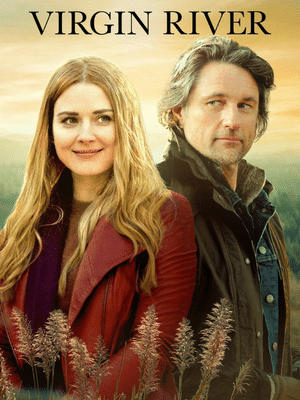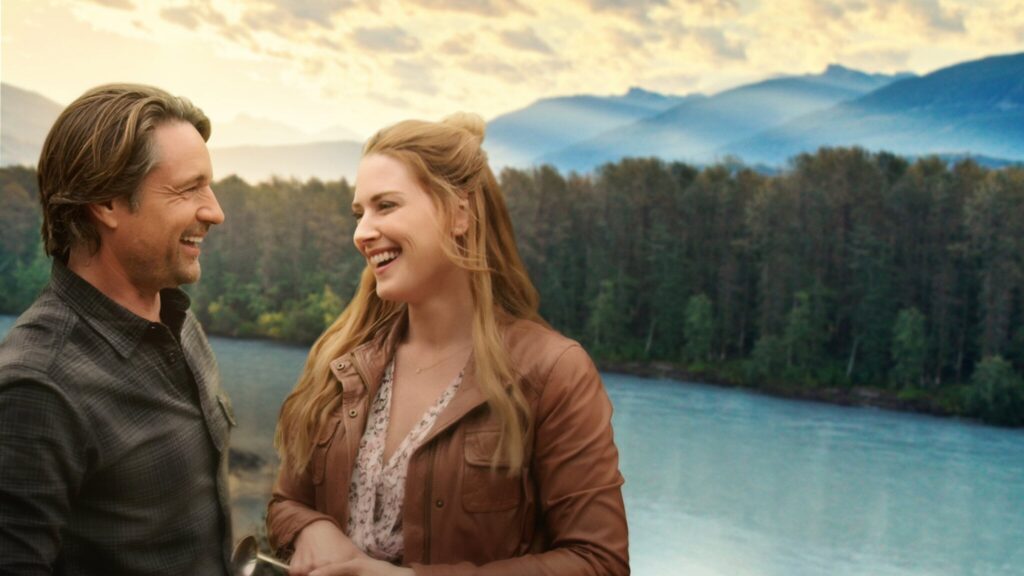Virgin River

TV-14, (2019 – ), Drama/Romance, 44m
Table of Contents
What Is Virgin River About?
A nurse seeks a fresh start in a remote town, finding unexpected romance and community healing.
Why You Should Watch Virgin River
Netflix’s Virgin River, adapted from Robyn Carr’s novels, is a tantalizing fusion of romance, drama, and a splash of picturesque nature. Set in the eponymous small town, the show follows Mel Monroe, a nurse practitioner, who relocates from the bustling urban life of Los Angeles, seeking solace and a fresh start after a cascade of personal tragedies. What she expects to be a simple transition swiftly transforms into an intricate journey of rediscovery, love, and confronting past traumas.
One of the standout elements of Virgin River is its atmospheric cinematography. The town, with its sprawling landscapes, dense woods, and serene rivers captured through breathtaking aerial shots, is reminiscent of a nature lover’s haven. It’s more than just a backdrop; it’s a character in its own right, setting the tone and pace for the narrative. The juxtaposition of the town’s serenity with the chaos of the characters’ lives provides a visually pleasing contrast, making the viewer yearn for a similar escape.

The series is skillfully anchored by Alexandra Breckenridge’s portrayal of Mel Monroe. Her nuanced performance encapsulates the fragility and strength of a woman grappling with grief while rediscovering her purpose. Martin Henderson, playing Jack Sheridan, complements her with an equally layered performance. His character, a bar owner with his own share of past demons, especially from his military service, becomes a pillar of strength and vulnerability, offering both support and complexity to the unfolding drama.
Beyond the main characters, Virgin River boasts a rich ensemble of personalities. From the meddling yet well-intentioned mayor, Hope McCrea, and the town’s seasoned physician, Doc Mullins, to the young, spirited Lizzie, each character is crafted with care, adding depth and diversity to the storyline. The dynamics among these characters often oscillate between heartwarming and heartbreaking, keeping the viewers on their toes.
However, while the series shines in many aspects, it does occasionally tread into predictable territory, especially within the romance genre’s typical tropes. Some conflicts seem manufactured, and resolutions, at times, come a tad too conveniently. But these moments are overshadowed by the genuine emotional beats the show consistently delivers.

What truly sets Virgin River apart is its mature handling of themes. The show doesn’t shy away from addressing complex issues like grief, PTSD, and miscarriage. It’s commendable how these heavy themes are balanced with lighter, more heartwarming moments, providing an emotional equilibrium.
Virgin River is more than just another romantic drama on the streaming platform. It’s a reflection on life’s multifaceted experiences, from the agonies of the past to the hopes for the future. While it occasionally succumbs to genre clichés, its strengths — the compelling performances, striking visuals, and earnest storytelling — make it a worthy watch. For those seeking a blend of romance, drama, and a visual treat, a trip to Virgin River is highly recommended.
The Theme of Virgin River
Virgin River, based on the novels by Robyn Carr, intricately weaves a multitude of themes that deeply resonate with its audience. Set in the picturesque landscape of a quaint rural town, the narrative depth of the series is a testament to the universality of its themes. At the very core of the story is the journey towards healing and redemption.
Mel Monroe, our protagonist, finds herself in Virgin River, seeking an escape from the haunting shadows of her past, marred by grief from the loss of her husband and unborn child. However, she is not alone in her quest for healing; characters like Jack Sheridan confront traumas of their own, notably scars from his military service. The serenity and simplicity of Virgin River, with its tight-knit community, play an instrumental role in the therapeutic journey of these characters.
Further enriching the narrative tapestry is the exploration of love and relationships. While the burgeoning romance between Mel and Jack is central, the series does not shy away from delving into the multifaceted nature of love — from the complicated dance of old love as seen with Hope and Doc to the challenges faced by Charmaine and Jack. The younger generation, represented by characters like Lizzie and Ricky, adds a fresh perspective on budding romance. Another significant theme the series addresses is that of community and belonging. The intimacy of a place where everyone knows everyone else presents both a haven of support and a hotbed for conflicts.

The series also contrasts the hustle and bustle of urban settings, as represented by Mel’s life in Los Angeles, with the tranquility and simplicity of rural life in Virgin River. This dichotomy underlines Mel’s initial resistance and eventual embrace of her new surroundings. Intertwined with this is the theme of confronting one’s past. Many of the town’s residents, while seeking solace in its comforting embrace, come to realize that true healing comes from facing, not escaping, the specters of their past. The natural beauty of Virgin River plays more than a mere aesthetic role. The forests, river, and mountains become a balm, offering solace and rejuvenation to troubled souls, making nature an integral character in the storyline.
Lastly, Virgin River is a poignant reminder of life’s unpredictability. Whether it’s Mel rediscovering love or Hope’s unexpected relationship twists with Doc, the narrative underscores the surprises and challenges life throws our way. In essence, Virgin River extends beyond its romantic drama label, serving as a reflection on life’s many complexities, from love and loss to healing and rediscovery. Through its characters and tales, it beckons viewers to appreciate the beauty in life’s imperfections and its unpredictable paths.
The Cinematography of Virgin River
The series is set in the fictional town of Virgin River, but its real-life locations in British Columbia serve as the lush, picturesque backdrop that’s integral to the show’s appeal. The cinematography, employing naturalistic lighting and wide shots, aptly captures the beauty, serenity, and ruggedness of the Northern Californian landscapes the story is set in.
One of the cinematographer’s standout features is its use of wide aerial shots. These drone shots capture the vastness of the landscapes – the winding rivers, dense forests, and looming mountains – and ground the series in its environment. The natural beauty contrasts with the often tumultuous lives of the characters, offering a sense of peace and escape, reinforcing the primary narrative of finding solace in nature.

Furthermore, the series also utilizes close-ups effectively, especially in emotional sequences, creating an intimate connection between the viewer and the characters. This juxtaposition of wide landscape shots and tight character close-ups underlines the interplay between the environment and personal stories.
The Soundtrack of Virgin River
The soundtrack of Virgin River serves as a poignant and atmospheric accompaniment to the series, elevating its narrative of love, loss, and rediscovery. The music is a curated blend of indie-folk, country, soft rock, and contemporary tracks that resonates with the show’s small-town, rustic setting and the emotional arcs of its characters.
The series employs its music in a way that complements and often contrasts with the unfolding drama. Many scenes in the show are underscored with gentle acoustic melodies, mirroring the serene landscapes and the peaceful escape the town offers. Conversely, during moments of heightened emotion or drama, the soundtrack might feature tracks with a more profound resonance, guiding the viewer’s emotional response.
Several popular songs have been featured throughout the series, enhancing key moments and adding depth to the narrative. Some of these include:
- “Whiskey Glasses” by Morgan Wallen – This country hit underscores moments of heartbreak and reflection.
- “The Night We Met” by Lord Huron – A melancholic track that’s been used in other shows too, it’s evocative of memories and lost love.
- “Die Trying” by Michl – A more contemporary sound that punctuates moments of determination and self-discovery.
- “Hold On” by Chord Overstreet – A poignant ballad that captures themes of love and longing.
The Cast of Virgin River
- Alexandra Breckenridge as Melinda “Mel” Monroe – A nurse practitioner and midwife who moves to Virgin River after the tragic death of her husband. She seeks a fresh start but finds that leaving her past behind isn’t as easy as she hoped.
- Martin Henderson as Jack Sheridan – A former Marine who runs the local bar. He takes an immediate interest in Mel when she arrives in Virgin River. He has his own traumas from his time in service.
- Annette O’Toole as Hope McCrea – The mayor of Virgin River. She’s opinionated and often inserts herself into others’ business, but it’s clear she cares deeply about the town and its inhabitants.
- Tim Matheson as Doc Mullins – The town doctor who initially resists Mel’s help, but later warms up to her. He has a complicated romantic history with Hope.
- Lexa Doig as Paige Lassiter – A local baker with a mysterious past who becomes friends with Mel.
- Colin Lawrence as Preacher – Jack’s friend and the cook at his bar. He has a strong moral code and later becomes involved in Paige’s life.
- Lauren Hammersley as Charmaine Roberts – Jack’s occasional fling before Mel comes to town. As the series progresses, her relationship with Jack becomes more complicated.
- Grayson Maxwell Gurnsey as Ricky – A young man who works at Jack’s bar. He respects and looks up to Jack, considering him a mentor.
- Sarah Dugdale as Lizzie – A young woman who moves to Virgin River and starts working at the local diner. She becomes involved with Ricky.
- Jenny Cooper as Joey Barnes – Mel’s older sister.
The Filmmakers of Virgin River
- Sue Tenney – The main showrunner and executive producer for Virgin River She’s also credited with developing the show for television based on Robyn Carr’s novels.
- Robyn Carr – The author of the Virgin River book series on which the show is based. While not directly involved in the day-to-day filmmaking, the series wouldn’t exist without her work.
- Roma Roth and Chris Perry – Executive producers for the series through their company Reel World Management.
- Jocelyn Freid, Tess Finley, and Erin Freid are also among those credited as producers for the series.
- Various Directors – Multiple directors have worked on Virgin River throughout its seasons. Some of these include Gail Harvey, Andy Mikita, Martin Wood, and others.
- Various Writers – Apart from Sue Tenney, there have been several writers who have contributed to the episodes, crafting the adaptation from book to screen.

BBQ Chicken Salad

Inspiration
Mel Orders A BBQ Chicken Salad


